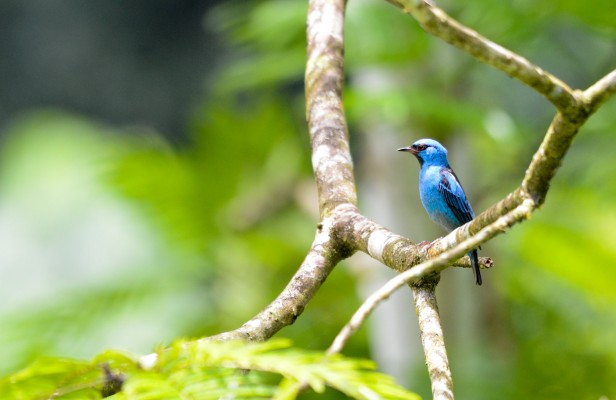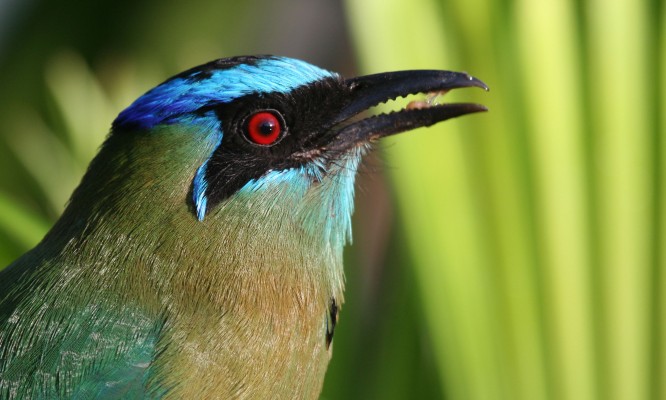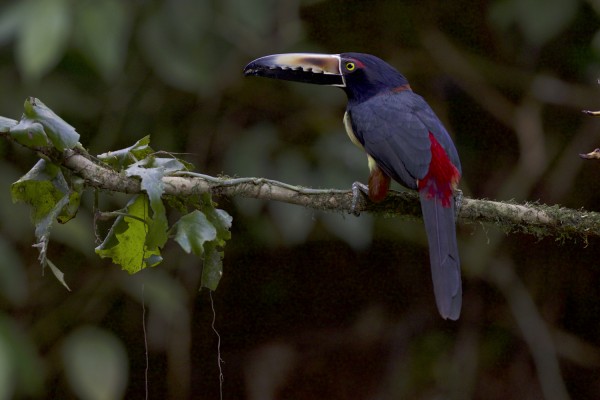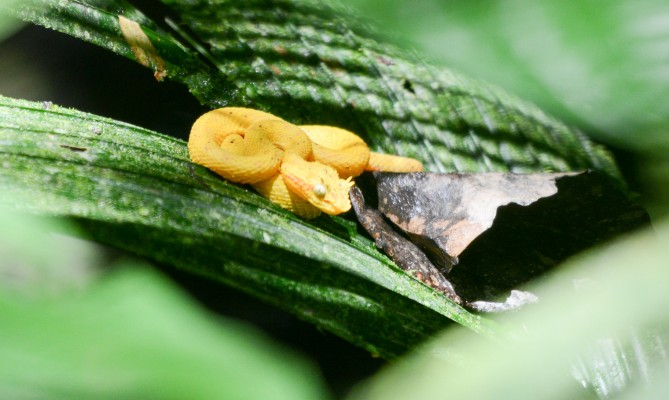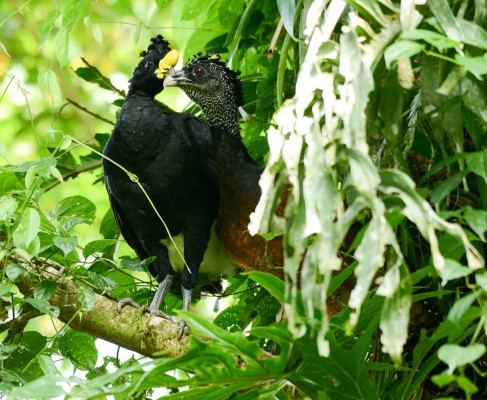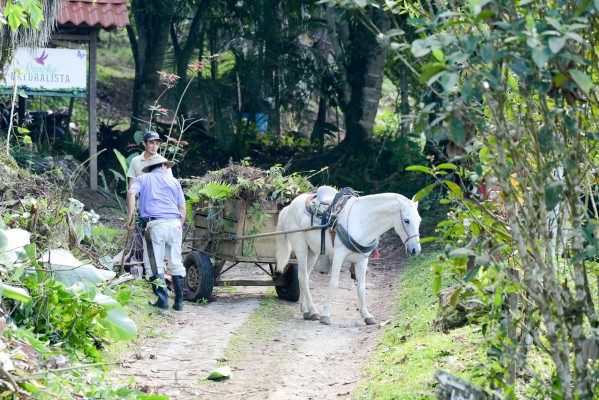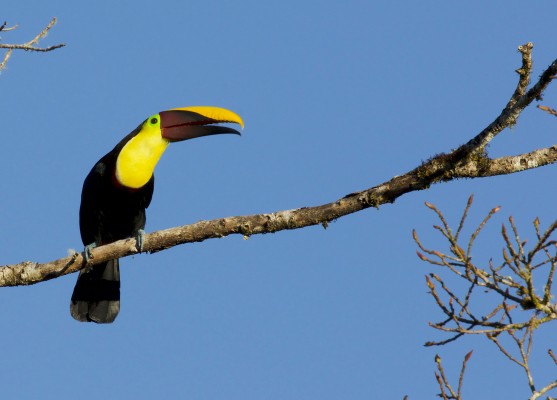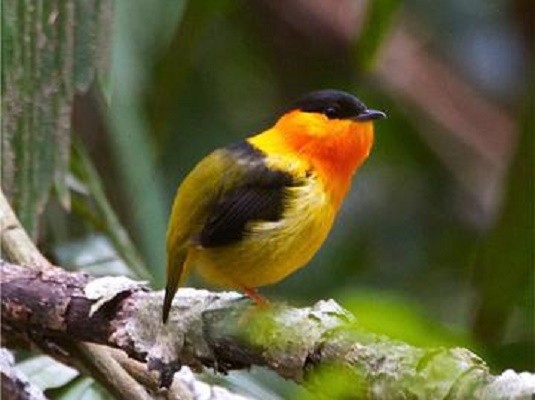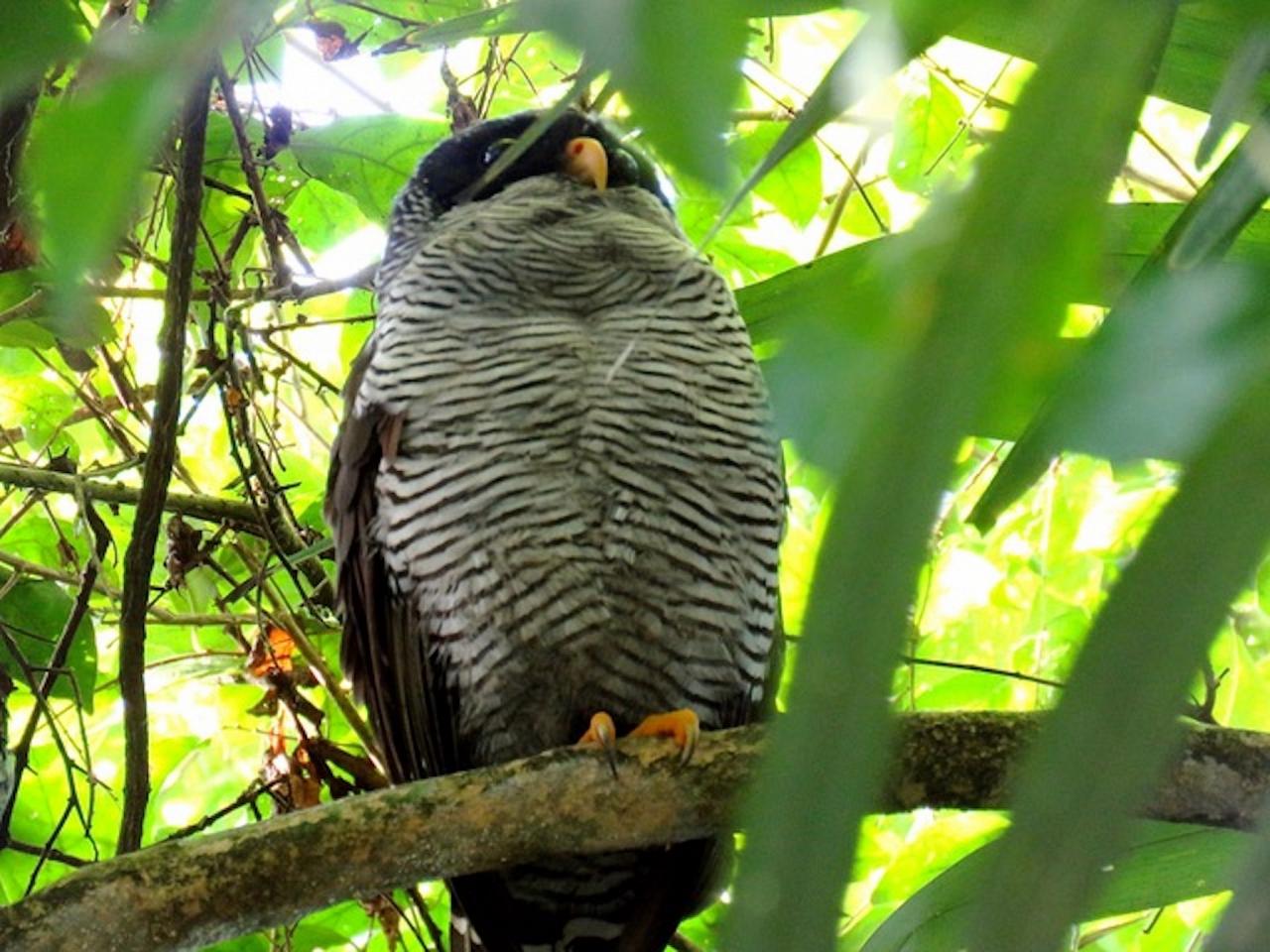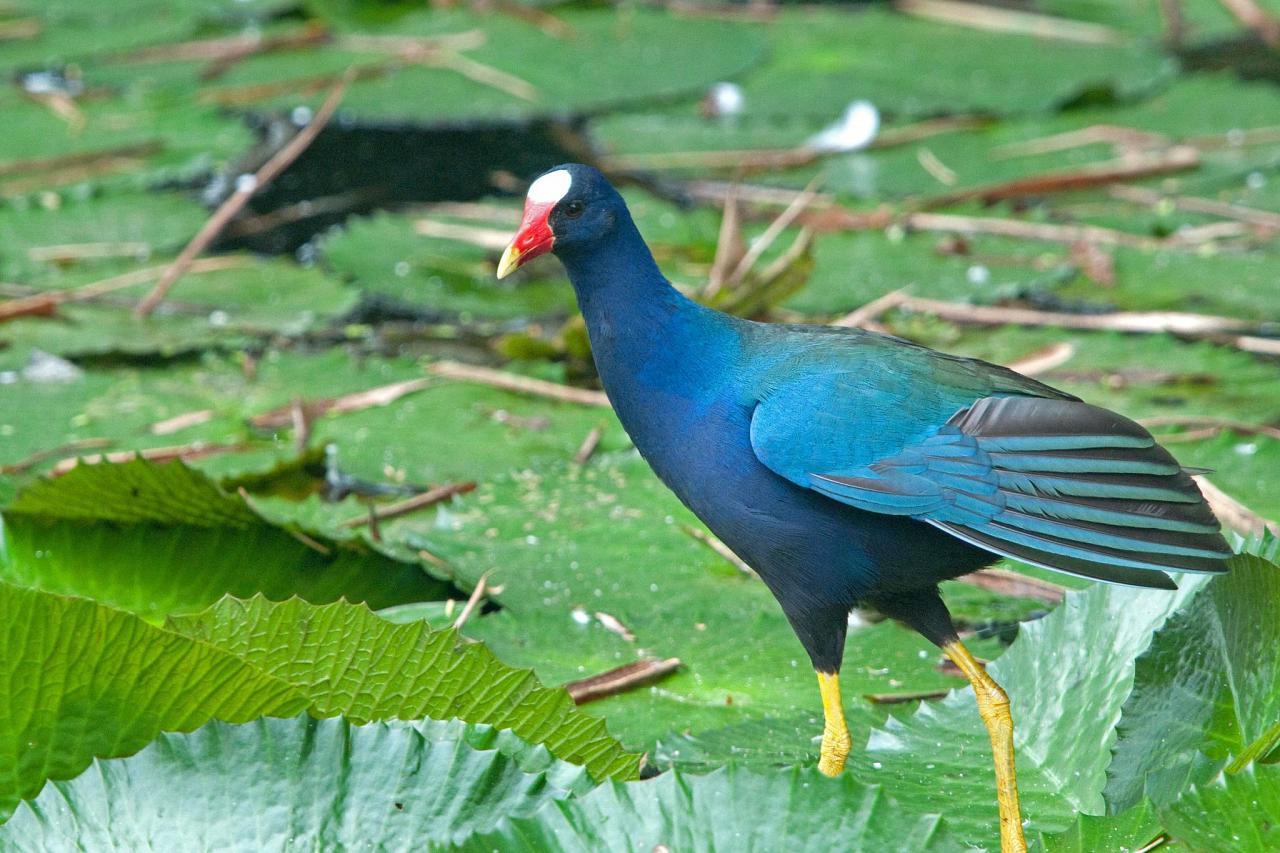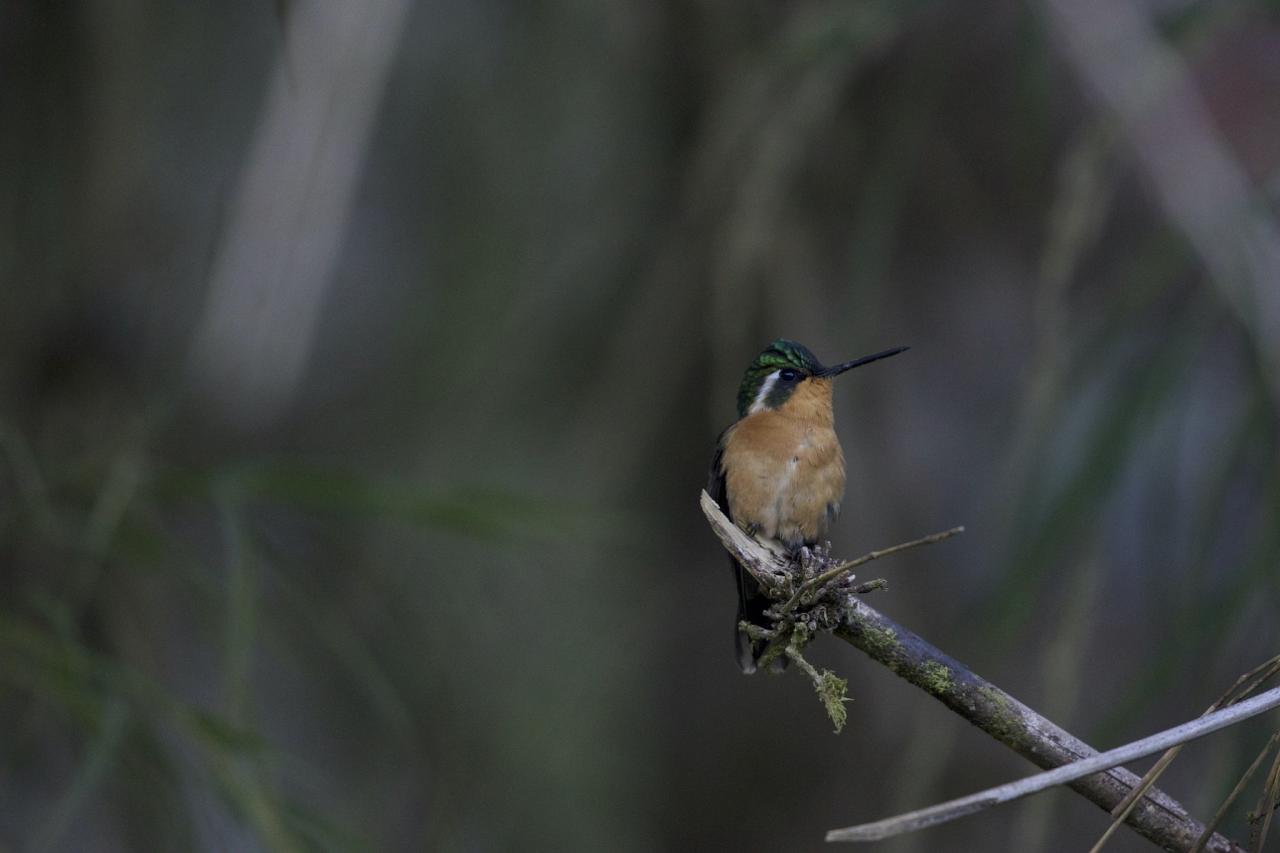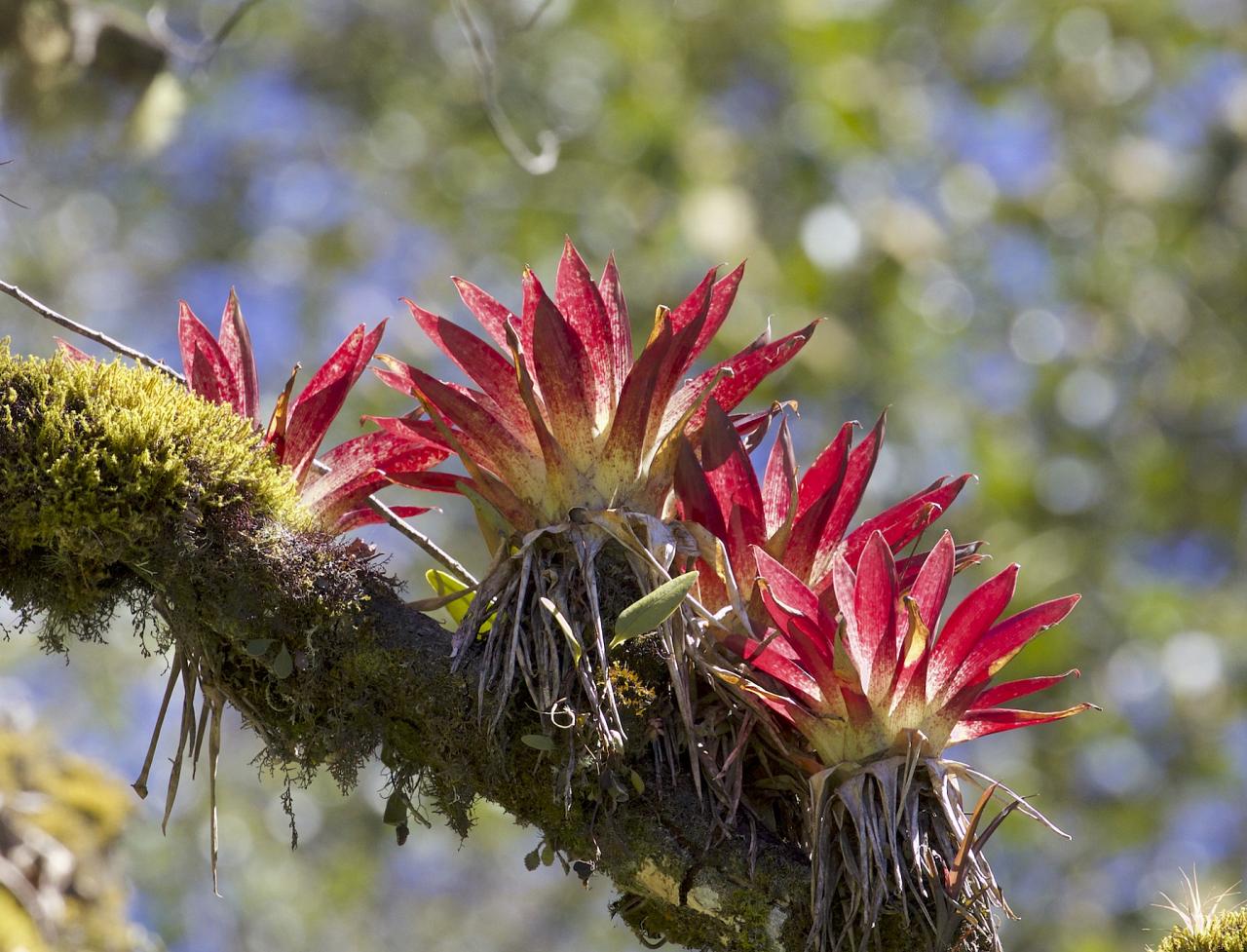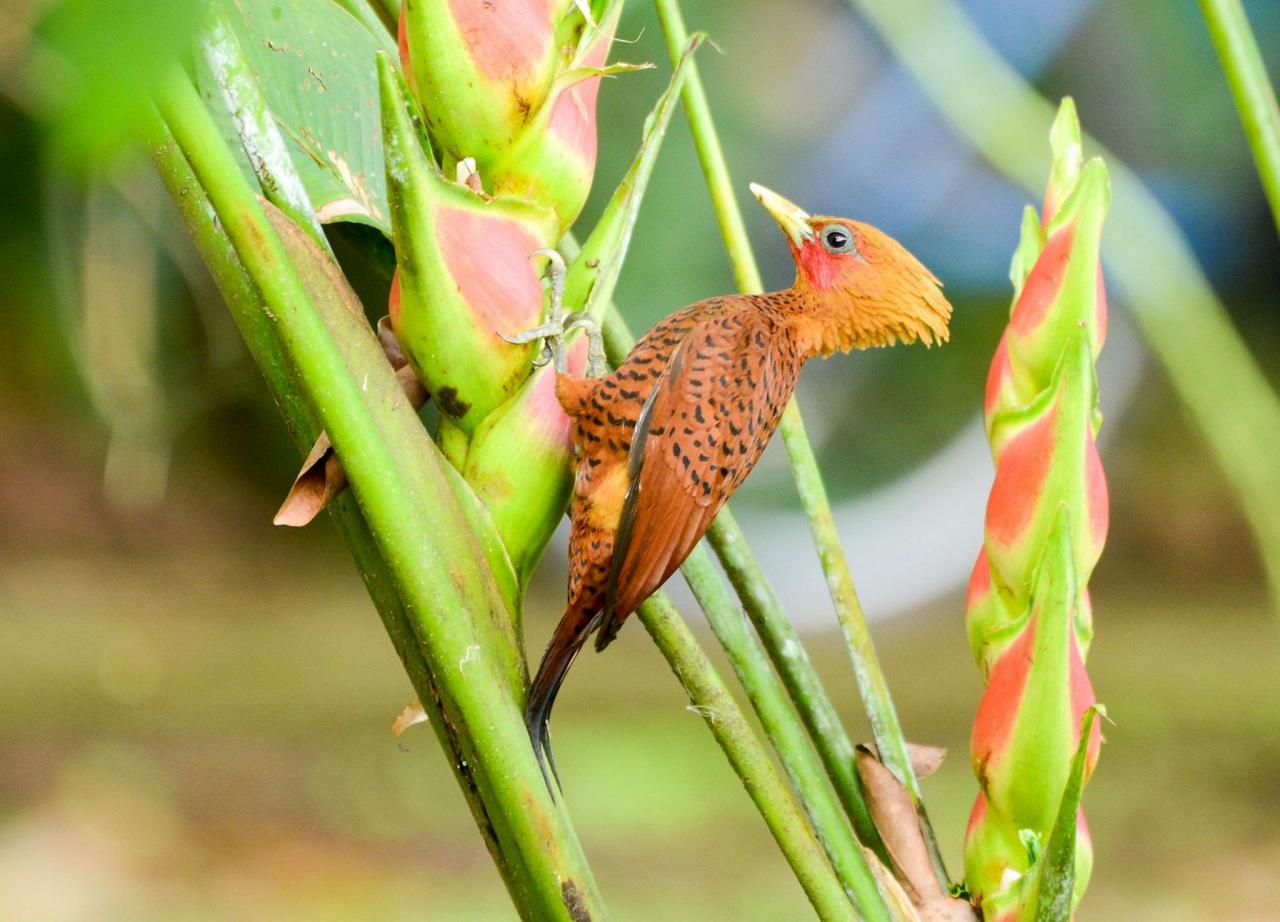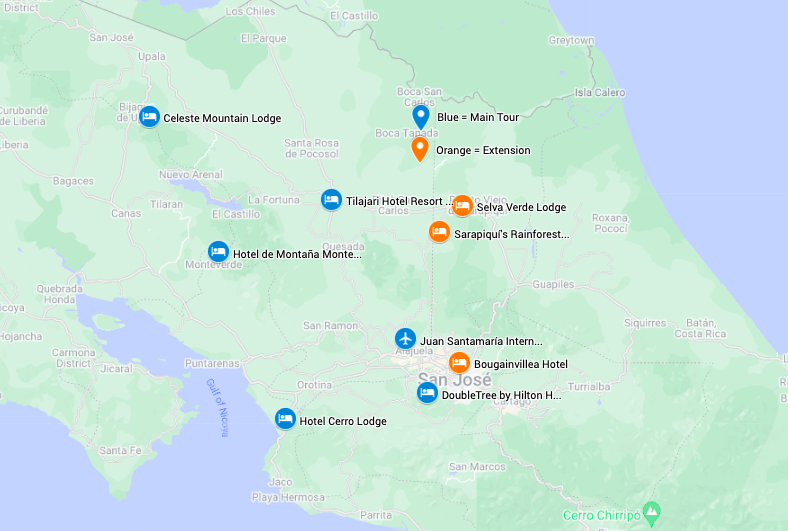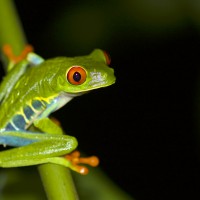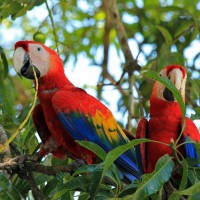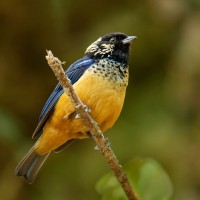- Overview
- Full Itinerary
- Extensions
- Photo Gallery
- Costing
- Travel Details
- Trip Reports
- Guide
- Map
- Know Before You Go
- Other Trips You May Like
There are very few places in the world that rival Costa Rica’s ecological diversity. More than a quarter of the country is protected lands, boasting 850 bird species and 200+ mammals.
Explore within the verdant Monteverde cloudforest—in search of the dazzling Resplendent Quetzal, lovely Long-tailed Manakin, and bizarre Three-wattled Bellbird. Immerse in tropical wonder at Celeste Mountain Lodge in the shadow of the Tenorio and Miravalles Volcanoes. Discover the Caño Negro area, rich in colorful waders like Roseate Spoonbill and Purple Gallinule, and perhaps even Jabiru; here you can opt for an after dinner drive to search for night birds and mammals.
We also offer an optional extension to explore La Selva Biological Station’s Neotropical specialties and the Sarapiqui area’s Caribbean lowlands. A great way to further immerse yourself in Costa Rica’s beautiful biodiversity.
Tour Highlights
- A perfect way to start—the lovely Hotel Bougainvillea; bird their 10-acre botanical garden
- Watch for hummingbirds, trogons, and mammals, too, from Monteverde Mountain Lodge, nestled in lush cloudforest
- Experience the Santa Elena Cloud Forest Reserve in search of Northern Emerald-Toucanet, and Purple-throated Mountain-gem and Magenta-throated Woodstar busy at feeders
- Unpack & relax at the Celeste Mountain Lodge in the heart of the Tenorio-Miravalles Biological Corridor
- Search for the elusive Tody Motmot and the outrageous Bare-necked Umbrellabird
- Wander Tenorino National Park in search of butterflies, trogons, hummingbirds, and perhaps antbirds following an army ant swarm
- Opt for a night drive to search for Black-and-white, Striped, and Tropical Screech-Owls, as well as Great and Northern Potoos
- Look for Sungrebe, Russet-naped Wood-Rail, and Yellow-breasted Crake at Lago Caño Negro
- Extend your stay with an extension to La Selva Biological Research Station and the Sarapiqui River area
Trip Itinerary
Itineraries are guidelines; variations in itinerary may occur to account for weather, road conditions, closures, etc. and to maximize your experience.
Wed., Mar. 18 Arrivals in San Jose | Hotel Bougainvillea
Bienvenido a Costa Rica! You are met at the airport for a transfer to our hotel in the hills of the historic suburb of Heredia. The Bougainvillea hotel is a family-owned and operated hotel with a welcoming atmosphere; fresh-cut flowers from the 10-acre garden, and original paintings and sculptures by leading local artists adorn the interior. Massive beamed ceilings, wood paneling, and a fireplace all contribute to the warm feeling of a country inn. And, there are always great birds to greet you as you stroll trails through the garden.
Tonight we gather to enjoy a welcome dinner and the chance to meet your guides and travel companions.
Accommodations at the Hotel Bougainvillea (D)
Thurs., Mar. 19 Central Pacific Coast
After leaving friends at the airport, our group continues on its way to the Central Pacific area, where we stay in a lovely valley with a rushing river, close to the Pacific Ocean. We arrive in time for lunch. The hotel and dining room sit aside a small river, and there is a steady stream of species coming in, including toucans and aracaris.
This afternoon we take a mangrove boat trip on the Tarcoles River. This is a great complement to our boat trip on the Sarapiqui, showing you two sides of the country. If time permits, especially if we have not seen macaws on our boat trip, we stop on a high bridge with expansive views. Though busy with traffic, this is the best place in Costa Rica to watch for Scarlet Macaw returning to roost sites. Their calls alert us and, as we wait to see their dazzling colors, we find a host of other species such as Mealy Parrot and, close-at-hand, noisy Rufous-naped Wren.
Accommodations at Cerro Lodge or Macaw Lodge (B,L,D)
Fri., Mar. 20 Carara National Park | Monteverde
We start early for a great morning of birding at Carara National Park, where we witness the diversity of birds and fauna in this transitional forest. Here we walk the trails and search for birds, butterflies, and mammals. This is the northern reach of species at home in Pacific Rainforest, and the southern reach for those associated with Pacific Dry Forests—this park’s diversity is some of the highest in the entire Central American region.
The open nature of Carara’s transitional forests lends itself well to finding birds that are normally difficult to observe elsewhere, such as Great Tinamou, Collared Forest-Falcon, and Streak-chested Antpitta. It’s also an excellent place to observe an army ant swarm and its attendant antbirds, including sometimes secretive Black-hooded Antshrike, Bicolored Antbird, Dusky Antbird, and Chestnut-backed Antbird. We may also find Scaly-breasted Hummingbird or Blue-throated Goldentail.
By mid-morning activity slows down, and we depart for higher elevations in the mountains, a couple of hours away. We enjoy lunch en route. Monteverde is a treasured location in Costa Rica where many birders get their first feel for birding lush montane forests. Remote, Monteverde has retained its charm despite its popularity and is still an excellent place for birding. We stay three nights to access several reserves. Plus, we have great birding right outside our door on the lodge grounds!
Our hotel, the Monteverde Mountain Hotel, sits amongst 15-acres of private forest at 4,500 feet above sea level. This mountain hotel has cozy rooms set in nicely kept grounds and features hummingbird feeders in the veranda.
Late in the afternoon, we enjoy birding at the Children’s Eternal Forest. This reserve was established with donated funds from children in 44 countries and is managed by a non-profit foundation. The property has a more open woodland than others in Monteverde due to a rain shadow effect. Long-tailed Manakin, often found in drier coastal forests, can be found here. We also hope to see Rufous-capped Warbler, Rufous-and-white Wren, and with some luck more elusive species like Northern Barred-Woodcreeper and Orange-billed Nightingale Thrush.
Watch for Swallow-tailed Kite on the move overhead in the late afternoon. Our dinner is well-prepared local Costa Rican food at the hotel.
Accommodations at the Monteverde Mountain Hotel (B,L,D)
Sat., Mar. 21 Monteverde Cloudforest Reserve | Curicancha Reserve
This morning we visit the famous Monteverde Cloud Forest Reserve, one of the best places to find Resplendent Quetzal. March is their breeding season, making our quest for this beauty a bit easier. Other lush highland forest species include Black Guan, Gray-breasted Wood Wren, Black-faced Solitaire, and with luck Silvery-fronted Tapaculo. Monteverde is a great place to spy a mixed flock, with Spotted Barbtail, Buffy Tuftedcheek, and Ruddy Treerunner probing bromeliads and mossy tree limbs while Spangle-cheeked Tanager searching for fruit in the canopy. This place is a wonderland for botany fans.
This afternoon we visit Curicancha Reserve, a small reserve (200 acres) but a true gem. Here, we get another chance to see Resplendent Quetzal, alongside Three-wattled Bellbird, Collared Trogon, Gray-throated Leaftosser, and other species. At hummingbird feeders, we may add Purple-throated Mountain Gem, Green-crowned Brilliant, Violet Sabrewing, and Magenta-throated Woodstar. With luck we could find mammals, too: Hoffmann’s Two-toed Sloth, Mantled Howler Monkey, White-faced Capuchin, or Kinkajou.
Accommodations at the Monteverde Mountain Hotel (B,L,D)
Sun., Mar. 22 Santa Elena Cloud Forest Reserve
This morning, we visit a reserve that is less well-known than Monteverde but has equally stunning and diverse forests. Encompassing approximately 730 acres, the Santa Elena Cloud Forest Reserve was established in 1992 through the combined initiatives of the Santa Elena Community High School and Canadian-based Youth Challenge International. During our time in this verdant reserve, we scan the moss-laden trees for regional endemics such as Collared Redstart, Black Guan, and Collared Trogon, while also paying close attention to the trail ahead of us for secretive ground-dwelling species such as Buff-fronted Quail-Dove and Black-breasted Wood-Quail. However, the true stars of this forest are the incomparably beautiful Resplendent Quetzal, a contender for most beautiful bird of the world, and the bizarre Three-wattled Bellbird, the source of a call that rings throughout the cloud forest during this time of the year.
Other species we hope to see include Northern Emerald-Toucanet, Prong-billed Barbet, Chestnut-capped Brushfinch, Costa Rican Warbler, and Golden-browed Chlorophonia. Be sure to watch for Orange-kneed Tarantula!
Best of all, in addition to trails, there are feeders, where Green Hermit, Green-crowned Brilliant, Purple-throated Mountain-gem, Magenta-throated Woodstar, Violet Sabrewing, Stripe-tailed Hummingbird, and Coppery-headed Emerald all put on a show.
Enjoy the afternoon to bird the hotel surroundings, or some may wish to see artisan shops in the town of Monteverde. Dinner tonight is at the lodge.
Accommodations at the Monteverde Mountain Hotel (B,L,D)
Mon., Mar. 23 Celeste Mountain Lodge | Tenorio & Miravalles Volcanoes
We can spend the early morning hours birding at the lodge and vicinity before we descend to another delightful area of Costa Rica, based for two nights at Celeste Mountain Lodge. Located on the slopes of the Tenorio Volcano, the lodge is set within beautiful mid-elevation Caribbean rainforest reserves of Tenorio Volcano National Park; this welcoming mountain lodge is an ideal base for the next two nights. Both Tenorio and Miravalles Volcanoes can be seen from the grounds, and the habitat here is inviting for many species.
Ecologically, the area is a mixing ground of Caribbean and Pacific influences that meet along the ridgeline. The lodge is in the heart of the Tenorio-Miravalles Biological Corridor, which provides biological linkage between Lake Nicaragua and the delta of the Tempisque River, one of Costa Rica’s major waterways, in the south.
After we check in at our lodge and settle in, we enjoy some free time to relax and get familiar with the grounds. The architecture is modern, with lots of glass and a stunning view of the mountains. A parade of colorful tanagers, orioles, and woodpeckers visit the fruit feeders within view of the lodge restaurant! The lodge sits at 2400 feet, quite a bit lower than Monteverde so we have new species to find here, as well as a second chance at some more general mountain species. Of the specialties, some are elusive to find including Tody Motmot, White Hawk, Yellow-eared Toucanet, Great Curassow, Ocellated Antbird, Dull-mantled Antbird, Lattice-tailed Trogon—imagine!
They take their food very seriously here and dinner is a real treat, blending foods of the region into European cuisine.
Accommodations at Celeste Mountain Lodge (B,L,D)
Tues., Mar. 24 Tenorio National Park | Celeste Mountain Lodge
Early birders can join our guides for birding in the garden, where Rose-breasted Grosbeak and Summer Tanager may join regional specialties like Snowcap and Violet-headed Hummingbird. While in the volcanos region, we explore primary rainforest where over 300 species of birds have been recorded. The closest village is Bijagua, which retains a rural charm and a tradition of cattle raising and agriculture.
Today we explore Tenorio National Park’s system of trails looking for specialties like the toy-like Tody Motmot, Stripe-throated Hermit, and various Heliconia butterflies. While we bird this prime tract of forest, the calls of antbirds in the understory may alert us to an army ant swarm, giving us our best chance to see some truly special obligate ant-followers such as Ocellated and Bicolored Antbird.
The park is adjacent to our lodge, and while visiting we are on the lookout for some of the area specialties, including Purplish-backed Quail Dove, Brown-hooded Parrot, White-ruffed Manakin, Broad-billed Motmot, Slaty-tailed Trogon, and Rufous-winged Tanager. We may, with some luck, find the often secretive Black-throated Trogon.
As the day ends, enjoy birding from the lodge’s balcony as sounds of night birds and darkness descend. Then, off to a delicious meal! There is also an optional night walk after dinner to look for the amazing Red-eyed Tree Frog and Masked Tree Frog.
Accommodations at Celeste Mountain Lodge (B,L,D)
Wed., Mar. 25 Caño Negro | Optional Night Tour
Awaken to sounds of the forest. After breakfast, we pack up to have time to bird and explore as we drive to our next lodge. Farm fields invite new species and vistas of mountains and fertile fields invite a few photo stops. We have even seen Great Green Macaw on this route! We have our lunch en route.
We are bound for the Caño Negro area, where we settle into delightful lodgings at the lowest elevation of our tour. Our comfortable rooms have well-designed furniture, ceiling fans, and air conditioning. We arrive in time to watch colorful tanagers and parakeets at the feeders. Garden birds include Spot-breasted Wren, White-tipped Dove, Yellow-throated Euphonia, Red-legged Honeycreeper, Orange-chinned Parakeet, and more. At dusk, watch the sky for Red-lored Parrot as they come in to roost.
Some may want to take a dip in the pool or just enjoy the grounds. Tonight, we enjoy international cuisine at the lodge’s Jabiru restaurant. Named after one of the tallest flying bird in the Americas, this restaurant offers a charming atmosphere and great views of the gardens.
After dinner, we offer an optional night tour, where we search for owls (Black-and-white, Striped, and Mottled), two species of potoo (Great and Northern), and perhaps even a large mammal or two!
Accommodations at Cano Negro Lodge (B,L,D)
Thurs., Mar. 26 Caño Negro National Wildlife Refuge | Caño Negro
Our lodge is located in the Caño Negro National Wildlife Refuge, one of the most important biological areas of the country and among the most important wetland areas in the world. It is an official Ramsar site, hosting a large area, almost 25,000 acres, replete with lagoons and extensive river habitat.
We have a boat trip this morning. What might we find here? Several kingfishers hunt along the river—Ringed, Amazon, and Green are the species we’re most likely to see. Particularly beautiful are the Bare-throated Tiger-Heron and the elusive Sungrebe; with luck we may also find roosting Boat-billed Heron. On tree limbs hanging over the water we watch for Black-collared Hawk and Snail Kite. Many describe this area as similar to the Florida Everglades—especially as we approach Lago Caño Negro, where we may find American Pygmy Kingfisher, Snowy Cotinga (wow!), and Bare-crowned Antbird, as well as Anhinga, Roseate Spoonbill, Black-bellied Whistling-Duck, Purple Gallinule, and large numbers of Snowy and Great Egrets. With luck we could find Yellow-breasted and Gray-breasted Crake.
A few (by name) remind us we are on the border of Nicaragua: Nicaraguan Seed-Finch, Nicaraguan Grackle, and Nicaraguan Slider-Turtle. In the forest margins, watch for Lineated Woodpecker, Scarlet-rumped Tanager, and Pied Puffbird.
In addition to birds, we may find Green Basilisk, Green Iguana, river turtles, Spectacled Caiman, American Crocodile, and more. One never knows what might be spotted here—the area is still wild enough to support populations of rare species such as Jabiru! Lunch is at a local restaurant.
Our hotel has a lovely bar if you want to gather for cocktails, and the dinner menu features international cuisine. After dinner we will do our final wildlife tally for the main tour, as tomorrow our group will split, some going on to the Caribbean Lowlands for our extension and others returning to Hotel Bougainvillea. Celebrate a great trip and all the sightings highlights!
Accommodations at Cano Negro Lodge (B,L,D)
Fri., Mar. 27 Return from Caño Negro OR Join Our Extension to La Selva/Sarapiqui
This morning early, we enjoy some last birding around the lodge grounds, feeders, and gardens. Then our flock disperses. Those on the extension depart soon after breakfast, with great birding planned along the way to Sarapiqui.
For those not opting for the extension, departing from the main tour, it's time to head back to San Jose. En route we will enjoy a lovely waterfall garden with hummingbird feeders en route to San José and then time at the lovely DoubleTree by Hilton Cariari where you can pack for travels, relax, enjoy the gardens, and share a final dinner with travel companions.
Main tour accommodations at the Hotel Bougainvillea (B,L,D)
Sat., Mar. 28 Departures
You may leave at any time convenient for you today. Please remember for an international flight it is recommended that you be at the airport 3 hours ahead, so the best departure time would be mid-to late morning and onward. (B)
La Selva/Sarapiqui Post-Tour Extension
Itineraries are guidelines; variations in itinerary may occur to account for weather, road conditions, closures, etc. and to maximize your experience.
Stay and Experience Costa Rica’s Caribbean Side
Add a blitz of biodiversity exploring Costa Rica’s Caribbean side in the lush Sarapiquí area. We boat on the Sarapiquí River, visit ‘Frog Heaven’ and spend quality birding time on the grounds of La Selva Biological Station. One of the world’s premier tropical research stations, La Selva’s 4,000-acre reserve connects with Braulio Carrillo National Park! More than 450 bird species have been recorded here, and this extension comes highly recommended.
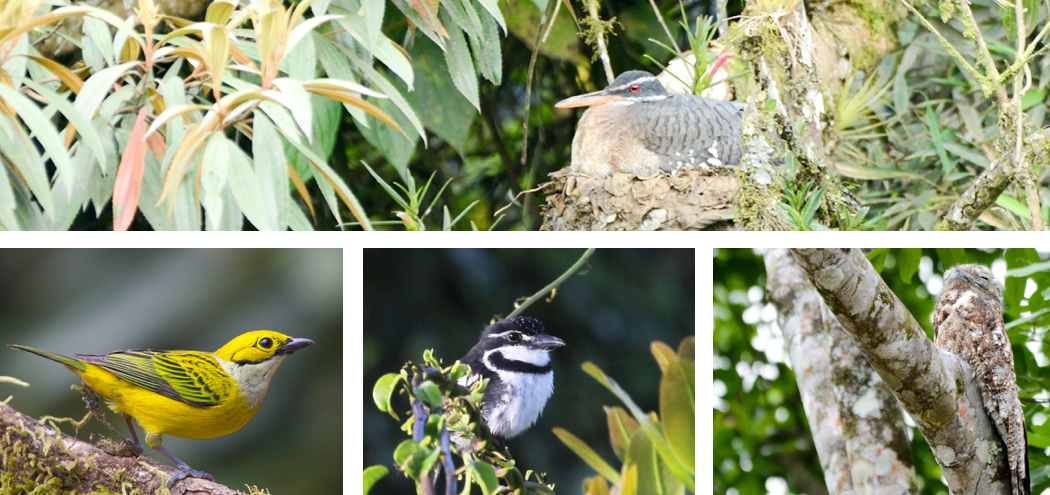
Fri., Mar. 27: Pierella Garden | Sarapiqui
This morning early, we enjoy some last birding around the lodge grounds, feeders, and gardens. Then our flock disperses. Those on the extension depart soon after breakfast, with great birding planned along the way to Sarapiqui.
Add a blitz of biodiversity! We do encourage those with time to see more of the country by exploring the Caribbean side in the lush Sarapiqui area on our extension. It is a scenic drive, and we arrive late-afternoon. Along the way, we stop at Pierella Garden, a fascinating small preserve for seeing both birds at close range, and technicolor butterflies. We then enjoy the Sarapiquis Rainforest Lodge grounds with our guide before dinner.
Extension Accommodations at Sarapiqui (B,L,D)

Sat., Mar. 28: La Selva Biological Station Sarapiqui River
Those who have joined the extension explore La Selva Biological Station this morning, one of the premier tropical research stations in the world. Trails wind between laboratories and researchers’ residences, and then fan out to primary and secondary forests where nature abounds. Lowland rainforest is particularly diverse here; the property is located near the confluence of two major rivers: the Rio Puerto Viejo and the Sarapiqui. The reserve is nearly 4,000 acres and connects to a forest corridor that ascends up through nearby Braulio Carrillo National Park, providing links to middle and higher elevations.
La Selva comprises 1,600 hectares (3,900 acres) of tropical wet forests and disturbed lands. Four major tropical life zones define the contiguous corridor now protecting a large portion of Costa Rica’s biodiversity. Recorded here are more than half of Costa Rica’s almost 900 species of birds, 1850 species of vascular plants, and a rich array of mammals, insects, reptiles, and amphibians. Each year, La Selva’s Christmas Bird Count is among the highest in numbers.
On trails near the Sarapiqui River we hope to see the beautiful Agami Heron and perhaps an elusive Sungrebe. Some of the other elusive species we may find include Great Curassow, Great Tinamou, Great Potoo, and Semiplumbeous Hawk. We should see Crimson-collared and Golden-hooded Tanager, Rufous and Broad-billed Motmot, Black-cheeked and Chestnut-colored Woodpecker, immaculate Snowy Cotinga, and, high on thermals above, King Vulture. Pied Puffbird and Rufous-tailed Jacamar are sit-and-wait predators that dart from perches to capture large insects. Orange-billed Sparrow are sharply patterned denizens of the forest floor.
Butterfly enthusiasts, prepare to be amazed at all the species, including several large electric-blue Morphos. Central American Agouti, Collared Peccary, and White-nosed Coati are mammals we often find.
In the late afternoon, we venture out on the Sarapiqui River for a boat trip; late afternoon is a great time to find secretive birds like Sunbittern, Green Ibis, Bare-throated Tiger-Heron, several kingfishers, herons, and egrets. Mealy and White-crowned Parrots make raucous noise overhead, joined by the smaller Olive-throated Parakeet. It’s beautiful to be out on the water where the temperature is cooler and views of the wildlife bound to impress.
Accommodations at Sarapiqui (B,L,D)
Sun., Mar. 29: Cinchona Waterfalls & Hummingbirds | Bougainvillea Hotel, San José
This morning we enjoy another full morning in the lush Caribbean lowlands of Sarapiqui. Birding spots abound, and we may also find tropical frogs such as Glass Frog or Poison Dart Frog
There are two routes that connect San José to Sarapiqui, and today we return to San José on the slower, more winding Vara Blanca route that has some pretty incredible scenery, and a waterfall to be remembered. A new Café de Colibris is open, the original one was devastated by an earthquake in 2009. At this roadside location, you can find up to ten species of hummingbird, including the lovely Green Thorntail—wow! We hope to also find Northern Emerald-Toucanet, and both Prong-billed and Red-headed Barbet. Buff-fronted Quail-Dove can often be seen wandering in the area below the feeders. The waterfall is situated across a massive drainage, an important biological corridor linking high mountain terrain with the Caribbean lowlands.
We watch for Bat Falcon, Squirrel Cuckoo, and Brown Jay, plus we have one more day to listen to the songs of Clay-colored Thrush and Rufous-collared Sparrow. We make a full field day of it today, arriving late-afternoon to our delightful lodgings at the Hotel Bougainvillea for a final dinner, with transfers out the following day.
Accommodations at the Hotel Bougainvillea (B,L,D)
Mon., Mar. 30: Departures
Enjoy birding on the grounds and depart today at your leisure. We arrange transfers for you to meet your International flights. Remember that you must be at the airport at least three hours ahead of your flight, so flights after 10:00 or 11:00 AM make for a more comfortable way to end your vacation! (B)
Cost of the Journey
Cost of the journey (main tour) is per person, based on occupancy: $5390 DBL / $6285 SGL, from San José, Costa Rica. Tour cost includes all accommodations, meals as specified in the itinerary, professional guide services, other park and program entrance fees and miscellaneous program expenses.
Cost of the La Selva/Sarapiqui extension is per person based on occupancy: $1190 DBL / $1450 SGL. Tour cost does not include: round-trip transportation from your home city to San José, optional activities, or items of a personal nature like laundry, telephone charges, maid gratuities, or beverages from the bar.
NEW! all tips other than your NJ guide (optional) and local guide are included (this includes tips for your driver, lodge and staff, day activities, meals and other services).
Travel Details
Please plan to make air travel plans only after the minimum group size has been met. We will send you a confirmation email as soon as the trip has been confirmed.
Arrival and Departure Airport: Juan Santamaria International Airport (SJO) in San Jose
Arrival Details: Please plan flights to arrive March 18, 2026 no later than 5:00 PM if you wish to join the group for dinner.
Departure Details: Please plan flight departures March 28, 2026 at your leisure. Keep in mind you must be at the airport three hours prior to flight departure so we suggest flights after 10:00 AM.
Extension Departure Details: Please plan flights to depart March 30, 2026 at your leisure. Keep in mind you must be at the airport three hours prior to flight departure so we suggest flights after 10:00 AM.
Travel Tips: If you arrive early to rest up from your travels, we can book extra nights for you with a transfer to our hotel, the Hotel Bougainvillea, which is in a residential area of the city. If you prefer to stay downtown and see the city, we have a few hotel recommendations below. If you choose to stay downtown, you’ll need to arrange a taxi or driver with the hotel to return to the airport for pickup or go out to the Bougainvillea to enjoy its gardens on the tour start date. There are many things to see in San Jose if you’re up for exploring! If you enjoy museums, you’re in luck because some of the best in Costa Rica are located right in San Jose. The Museo Nacional de Costa Rica has exhibits highlighting the archaeology and history of Costa Rica as well as a butterfly garden. The Pre-Columbian Gold Museum has one of the largest collections of gold artifacts in Latin America, some of which date back to 500 CE. If you’re looking to do some shopping or try some local food, head over to the Mercado Central (Central Market). You’ll find vendors selling fruits and vegetables, local food dishes, and a wide variety of souvenirs.
Downtown Hotel Recommendations: Hotel Presidente Hotel Grano de Oro
Entry Requirements: See "Essential Information" section under the "Know Before You Go" tab.
Browse below for trip reports and species lists from past versions of this and other tours from this destination.
Costa Rica
- January 2018
- October 2018
- January 2019
- March 2019
- January 2020
- March 2021
- December 2021 (Christmas in Costa Rica)
- February 2022
- March 2022
- December 2022
- January 2023
- February 2023
- July 2023
- October 2023
- December 2023 (Christmas Tour)
- January 2024
- February 2024
- July 2024
- October 2024
- January 2025
- February 2025 (Arenal Volcano)
- March 2025
Monteverde
- March 2022
- March 2023
- March 2024
- March 2025
Northern
- March 2012
- January 2013
- January 2017
Southern
- February 2007
- January 2017
- January 2018
- January 2019
- February 2023
-
David Jaffe

David Jaffe is an engaging naturalist inspiring people through his curiosity to develop meaningful connections with our home planet. He has been an avid birder since volunteering with the National Audubon Society in 1991. Over his 30+ year career in the outdoor industry, he has gained experience as a guide throughout the United States and on all seven continents. He is a certified National Geographic Photography instructor and works as a naturalist and lecturer on expedition ships. He helped establish a marine protected area off the coast of Madagascar and assisted with bird research projects in the United States, Canada and South America. He has led backcountry trips in Denali National Park and gained great insights while working as a Park Ranger in Yosemite and Sequoia National Parks. He is a passionate birder with a keen interest in geology, botany, and the intricacies of natural history. He loves this work and infuses every tour with his enthusiasm, knowledge and care.
Other trips with David Jaffe
-
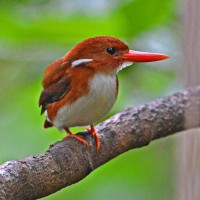 Madagascar: 8th Continent! 1 Single Room Available!November 4 - 18, 2025
Madagascar: 8th Continent! 1 Single Room Available!November 4 - 18, 2025 -
 Trinidad & Tobago: Incredible Birds & WildlifeJanuary 23 - February 1, 2026
Trinidad & Tobago: Incredible Birds & WildlifeJanuary 23 - February 1, 2026 -
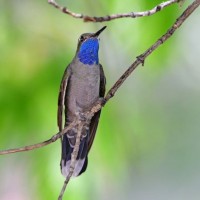 Southeast ArizonaMay 2 - 11, 2026
Southeast ArizonaMay 2 - 11, 2026 -
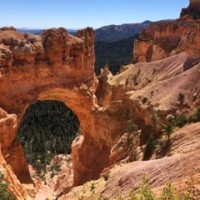 Birding Canyon CountryMay 17 - 25, 2026
Birding Canyon CountryMay 17 - 25, 2026
-
Essential Information +
Pace & Protocols +
Packing List +
Suggested Reading List +
Useful Links +
Photo credits: Banner: Black-cheeked Woodpecker by Greg Smith (GS); Lizard by Sandy Sorkin; Squirrel Cuckoo by Sandy Sorkin; Keel-billed Toucan by Doug Greenberg (DG); Black Howler Monkey by Peg Abbott (PA); Blue Dacnis by Sandy Sorkin; Lesson's Motmot by Peg Abbott; Collared Aracari by Greg Smith; Eyelash Pit Viper by Sandy Sorkin; Great Curassow Pair by Sandy Sorkin (SS); Rural Life by Sandy Sorkin; Yellow-throated Toucan by Greg Smith; Orange-collared Manakin by Bud Ferguson; Northern Barred Woodcreeper Phil Yates, courtesy Operador Latino; Black Guan, DG; Lesson's Motmot, Mike Boyce; Central American Squirrel Monkey, PA; View from Celeste Mountain Lodge, celestemountainlodge.com; Collared Aracari, James Adams; Red-legged Honeycreeper, GS; Great Curassow, SS; White-collared Manakin, SS; Red-lored Parrots, SS; Boat-billed Herons, CS; Great Egret, Betty Andres; Black-bellied Whistling Ducks, PA; Eyelash Pit Viper, SS; King Vulture, DG; Golden-hooded Tanager, PA; Black-cheeked Woodpecker, GS; Sunbittern, SS; Silver-throated Tanager, GS; Pied Puffbird, PA; Great Potoo, SS; Squirrel Cuckoo, SS; Black-and-white Owl, Howard Topoff; Purple Gallinule, Tom Dove; Purple-throated Mountain Gem, GS; Savegre Bromeliads, GS; Chestnut-colored Woodpecker, SS.






